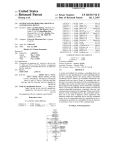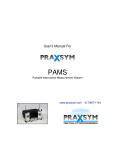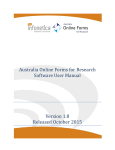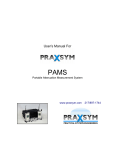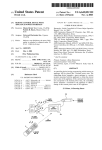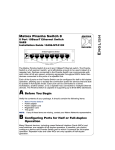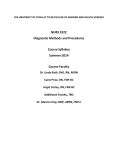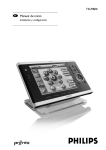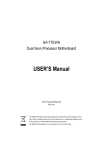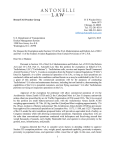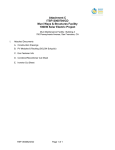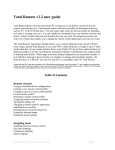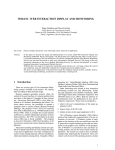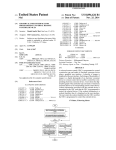Download IN THE UNITED STATES PATENT AND
Transcript
IN THE UNITED STATES PATENT AND TRADEMARK OFFICE
BEFORE THE PATENT TRIAL AND APPEAL BOARD
In re Patent of: Dresti et al.
Patent No.: 7,831,930
Petition for Inter Partes Review under
Filed: Nov. 6, 2002
35 U.S.C. §§ 311–319
Issued: Nov. 9, 2010
and 37 C.F.R. § 42.100 et seq.
Assignee: Universal Electronics Inc.
Title: SYSTEM AND METHOD FOR
DISPLAYING A USER INTERFACE
FOR A REMOTE CONTROL
APPLICATION
Mail Stop PATENT BOARD
Patent Trial and Appeal Board
United States Patent and Trademark Office
P.O. Box 1450
Alexandria, VA 22313-1450
PETITION FOR INTER PARTES REVIEW OF U.S. PATENT NO. 7,831,930
Petition for Inter Partes Review of U.S. Patent No. 7,831,930
TABLE OF CONTENTS
EXHIBIT LIST ............................................................................................ iv
I.
MANDATORY NOTICES .................................................................1
A.
Real Party-In-Interest .........................................................1
B.
Related Matters ....................................................................1
C.
Lead and Back-Up Counsel ................................................2
D.
Service Information .............................................................3
II.
PAYMENT OF FEES .........................................................................3
III.
REQUIREMENTS FOR INTER PARTES REVIEW .....................4
A.
Grounds For Standing .........................................................4
B.
Identification of Challenge ..................................................4
1. Claims for which inter partes review is requested.............4
2. The specific art and statutory grounds on which the
challenge is based .................................................................4
3. How the challenged claims are to be construed ................6
4. How the construed claims are unpatentable under the
statutory grounds identified in 37 C.F.R. § 42.104(b)(2) .6
5. Supporting evidence relied upon to support the
challenge................................................................................6
IV.
SUMMARY OF THE '930 PATENT ................................................7
A.
Summary of the Prosecution History of the '930
patent .....................................................................................9
V.
DETAILED CLAIM CONSTRUCTION .......................................10
VI.
THERE IS A REASONABLE LIKELIHOOD THAT AT LEAST
ONE CLAIM OF THE '930 PATENT IS UNPATENTABLE .....12
A.
Claim 1 is obvious over Realistic in view of Evans .........12
B.
Claim 1 is obvious over ProntoEdit in view of
Realistic ...............................................................................14
- ii -
Petition for Inter Partes Review of U.S. Patent No. 7,831,930
VII. DETAILED EXPLANATION OF HOW THE CHALLENGED
CLAIMS ARE UNPATENTABLE .................................................15
A.
Summary of Prior Art .......................................................15
1. Realistic Universal Remote Control Owner’s Manual
Cat. No. 15-1903 (Realistic - Exhibit 1003) ....................15
2. U.S. Patent No. 4,825,200 (“Evans,” Exhibit 1004) ........17
3. ProntoEdit User Guide (“ProntoEdit,” Exhibit 1005) ..19
B.
Detailed Grounds for Unpatentability Arguments .........21
1. Ground 1: Claim 1 is unpatentable as obvious over
Realistic in view of Evans under 35 U.S.C. § 103(a). ......21
1. Ground 2: Claim 1 is unpatentable as obvious over
ProntoEdit in view of Realistic under 35 U.S.C. § 103(a).
..............................................................................................28
VIII. CONCLUSION ..................................................................................33
- iii -
Petition for Inter Partes Review of U.S. Patent No. 7,831,930
EXHIBIT LIST
1001.
U.S. Patent No. 7,831,930 (filed Nov. 6, 2002) (issued Nov. 9, 2010)
to Dresti et al.
1002.
Prosecution history of U.S. Patent Application Serial No. 10/288,727,
which matured into the '930 Patent.
1003.
Realistic Universal Remote Control Owner’s Manual Cat. No. 151903
1004.
U.S. Patent No. 4,825,200 (filed Jun. 25, 1987) (issued Apr. 25, 1989)
to Evans et al.
1005.
ProntoEdit User Guide Version 2.0
1006.
Pronto Universal Intelligent Remote Control User Guide
1007.
RemoteCentral.com web page
http://files.remotecentral.com/view/3492-74411/aaron_hugharts_pronto_setup.html#comments
1008.
Declaration of Jim Geier In Support of the Petition for Inter Partes
Review of U.S. Patent No. 7,831,930 (“Geier Declaration”).
1009.
Complaint for Patent Infringement in Universal Electronics, Inc. v.
Universal Remote Control Inc., Civil Action No. SACV 13-00984,
filed June 28, 2013 (“Current UEI Litigation”).
- iv -
Petition for Inter Partes Review of U.S. Patent No. 7,831,930
1010.
Complaint for Patent Infringement in Universal Electronics Inc. v.
Peel Technologies, Inc., Civil Action No. SACV 13-01484, filed
September 23, 2013 (“Peel Litigation”).
1011.
Joint Claim Construction Chart Pursuant to S.P.R. 3.5.1 in Universal
Electronics Inc. v. Peel Technologies, Inc., Civil Action No. SACV
13-01484, filed June 13, 2104 (“UEI/Peel Claim Construction Chart”)
-v-
Petition for Inter Partes Review of U.S. Patent No. 7,831,930
Petitioner Universal Remote Control, Inc. (“Petitioner” or “URC”)
respectfully requests inter partes review of claim 1 of U.S. Patent No. 7,831,930
(the “'930 Patent,” attached as Ex. 1001) in accordance with 35 U.S.C. §§ 311–319
and 37 C.F.R. § 42.100 et seq.
I.
MANDATORY NOTICES
Pursuant to 37 C.F.R. § 42.8(a)(1), Petitioner provides the following
mandatory disclosures.
A.
Real Party-In-Interest
Pursuant to 37 C.F.R. § 42.8(b)(1), Petitioner certifies that Universal Remote
Control, Inc. is the real party-in-interest.
B.
Related Matters
Pursuant to 37 C.F.R. § 42.8(b)(2), Petitioner states that claim 1 of the '930
Patent is involved in the litigation presently styled Universal Electronics Inc., v.
Universal Remote Control, Inc., Ohsung Electronics Co., Ltd., and Ohsung
Electronics U.S.A., Inc., Case No. SACV 13-00984 AG (JPRx) (C.D. Cal.), filed
on June 28, 2013 ("2013 UEI Litigation"). Petitioner was the sole defendant in the
2013 UEI Litigation on July 2, 2013 and, consequently, the only defendant served
with a complaint in the 2013 UEI Litigation on July 2, 2013. The 2013 UEI
Litigation remains pending. The patents-in-suit are U.S. Patent Nos. 5,228,077,
-1-
Petition for Inter Partes Review of U.S. Patent No. 7,831,930
5,255,313, 5,414,761, 5,552,917, RE39,059, 6,407,779, 7,831,930, 7,126,468,
7,589,642, and 8,243,207.
Claim 1 of the ‘930 Patent has also been asserted in another litigation styled
Universal Electronics Inc., v. Peel Technologies, Inc., Case No. SACV 13-01484
AG (JPRx) (C.D. Cal.) filed September 23, 2013 (“the Peel Litigation”). See Ex.
1010. This litigation is currently pending. Petitioner has not been served with a
complaint of infringement in the Peel litigation and is not a defendant in the Peel
litigation.
This Petition for inter partes review is directed to U.S. Patent No. 7,831,930.
Petitions for inter partes review corresponding to the remaining nine patents in the
2013 UEI Litigation will also soon be filed. In light of this, the Patent Trial and
Appeal Board (PTAB) may wish to consolidate one or more of any other inter
partes review actions related to this matter to a single panel of Administrative
Patent Judges for administrative efficiency.
C.
Lead and Back-Up Counsel
Pursuant to 37 C.F.R. § 42.8(b)(3), Petitioner provides the following
designation of counsel:
-2-
Petition for Inter Partes Review of U.S. Patent No. 7,831,930
Lead Counsel
Back-Up Counsel
Peter H. Kang, Reg. No. 40,350
Douglas A. Miro
Theodore W. Chandler, Reg. No. 50,319
Ostrolenk Faber LLP
1180 Avenue of the Americas New Ferenc Pazmandi, Reg. No. 66,216
Sidley Austin LLP
York, NY 10036
1001 Page Mill Rd.
Telephone: (212) 596-0500
Building One
Facsimile: (212) 382-0888
Palo Alto, CA 94304
[email protected]
Telephone: (650) 565-7000
USPTO Customer No. 02352
Facsimile: (65) 565-7100
USPTO Reg. No. 31,643
[email protected]
USPTO Customer No. 37803
D.
Service Information
Pursuant to 37 C.F.R. § 42.8(b)(4), service information for lead and back-up
counsel is provided above.
II.
PAYMENT OF FEES
The undersigned authorizes the Office to charge to Deposit Account No. 150700 $9,000 for the request fee required by 37 C.F.R. § 42.15(a)(1) and $14,000
for the Post-Institution fee required by 37 C.F.R § 42.15(a)(2) for this Petition for
Inter Parties Review. Review of 1 claim is being requested, so no excess claims
fee is included in this fee calculation. The undersigned further authorizes payment
for any additional fees that might be due in connection with this Petition to be
charged to the above referenced Deposit Account.
-3-
Petition for Inter Partes Review of U.S. Patent No. 7,831,930
III.
REQUIREMENTS FOR INTER PARTES REVIEW
As set forth below and pursuant to 37 C.F.R. § 42.104, each requirement for
inter partes review of the '930 Patent is satisfied.
A.
Grounds For Standing
Pursuant to 37 C.F.R. § 42.104(a), Petitioner hereby certifies that the '930
Patent is available for inter partes review and that the Petitioner is not barred or
estopped from petitioning for inter partes review of the '930 Patent on the grounds
identified herein.
B.
Identification of Challenge
Pursuant to 37 C.F.R. § 42.104(b), the precise relief requested by Petitioner
is that the PTAB cancel as unpatentable claim 1 of the '930 Patent.
1.
Claims for which inter partes review is requested
Pursuant to 37 C.F.R. § 42.104(b)(1), Petitioner requests inter partes review
of claim 1 of the '930 Patent.
2.
The specific art and statutory grounds on which the
challenge is based
Pursuant to 37 C.F.R. § 42.104(b)(2), inter partes review of the '930 Patent
is requested in view of the following references, each of which is prior art to claim
1 of the '930 Patent under one or more of 35 U.S.C. § 102(a), (b), and/or (e):
-4-
Petition for Inter Partes Review of U.S. Patent No. 7,831,930
(1)
Realistic Universal Remote Control Owner’s Manual Cat. No. 15-
1903 (Realistic) was published in 1989 by Tandy Corporation. Realistic is prior
art to the ‘930 patent at least under 35 U.S.C. § 102(b).
(2)
U.S. Patent No. 4,825,200 was filed Jun. 25, 1987, and issued on
April 25, 1989, to Evans et al. (Evans). Evans is prior art to the ‘930 patent at least
under 35 U.S.C. § 102(b).
(3)
ProntoEdit User Guide Version 2.0 was published in September,
2000, by Philips Electronics N.V. (ProntoEdit). ProntoEdit is prior art to the ‘930
patent at least under 35 U.S.C. § 102(b).
The Realistic, Evans, and ProntoEdit references were not considered during
prosecution of the ‘930 patent. Realistic, Evans, and ProntoEdit present new, noncumulative technological teachings. A detailed discussion of the references and
their applicability to claim 1 of the '930 patent is provided starting at Section VII
(B) below.
Pursuant to 37 C.F.R. § 42.104(b)(2), inter partes review of the '930 Patent
is requested on the following grounds.
Ground 1. Claim 1 is unpatentable as obvious over Realistic in view of
Evans under 35 U.S.C. § 103(a).
Ground 2. Claim 1 is unpatentable as obvious over ProntoEdit in view of
Realistic under 35 U.S.C. § 103(a).
-5-
Petition for Inter Partes Review of U.S. Patent No. 7,831,930
3.
How the challenged claims are to be construed
The ‘930 patent has not expired. Pursuant to 37 C.F.R. § 42.100(b), the
claims of an unexpired patent subject to inter partes review receive the “broadest
reasonable construction in light of the specification of the patent in which [they]
appear.” Claim 1 of the ‘930 patent does not include means-plus-function or stepplus-function limitations.
4.
How the construed claims are unpatentable under the
statutory grounds identified in 37 C.F.R. § 42.104(b)(2)
Pursuant to 37 C.F.R. § 42.104(b)(4), an explanation of how claim 1 of the
‘930 patent is unpatentable under the statutory grounds identified above, including
an identification of where each element is found in the prior art patents or printed
publications, is provided in Section VII.B below.
5.
Supporting evidence relied upon to support the challenge
Pursuant to 37 C.F.R. § 42.104(b)(5), the exhibit numbers of the supporting
evidence relied upon to support the challenges are provided in an exhibit list
included herein. The following text of the present Petition identifies the relevance
of the evidence to the challenges raised and identifies specific portions of the
evidence to support the challenges raised under the grounds of unpatentability.
Further supporting evidence, including detailed discussions of the respective prior
art references, is provided in the Geier Declaration (Ex. 1008).
-6-
Petition for Inter Partes Review of U.S. Patent No. 7,831,930
IV.
SUMMARY OF THE '930 PATENT
The ‘930 patent is directed to a “hand-held electronic device having a
remote control application user interface that functions to displays operational
mode information to a user.
The graphical user interface may be used, for
example, to setup the remote control application to control appliances for one or
more users in one or more rooms, to perform activities, and to access favorites.”
See Ex. 1001 at Abstract. “The user may be able to specify a list of favorite
channels for a number of categories. The favorites lists may be synchronized with
the channel lineup offered by a cable or satellite service provider.” Id. at 12:14-18.
“The remote control application may provide one or more favorites pages
containing button icons which the user may configure for direct access to his
favorite programming (e.g., example, to cause the transmissions of commands to
cause a device to tune to a favorite channel), favorite device, etc. … An exemplary
favorites page is illustrated in FIG. 17a.” Id. at 19:25-45.
-7-
Petition for Inter Partes Review of U.S. Patent No. 7,831,930
The ‘930 patent further explains that “[i]t will also be appreciated that
favorites pages may be specific to particular devices (e.g. a satellite STB or a CD
jukebox) while in other instances favorites pages may span multiple devices in
order to allow access to all of a user's favorite media content from a single point of
access.” Id. at 19:40-45.
Independent claim 1 of the ‘930 patent is directed to software for a handheld
device to allow multiple lists of favorite channels to be defined and accepting input
to place the hand held device into a mode to control a home appliance and, in
response, using that input to select the list of favorite channels associated with that
home appliance. See Ex. 1001 at 38:27-47; see also Ex. 1008 at ¶ 24.
-8-
Petition for Inter Partes Review of U.S. Patent No. 7,831,930
A.
Summary of the Prosecution History of the '930 patent
The application for the ‘930 patent was filed on November 6, 2002, claiming
priority to two provisional applications filed in November and December of 2001.
The ‘930 patent names Universal Electronics Inc. (UEI) as assignee and Dresti et
al. as inventors. See Ex. 1001 at p. 1.
Original claims 1-73 were subject to a restriction requirement. Ex. 1002 at
p. 382.
The applicants selection included original claim 33 directed to user
specific favorite lists and original claim 35 directed to appliance specific favorite
lists. Id. at 389.
The Examiner rejected the selected claims as unpatentable over the prior art,
including the Williams ‘988 patent which disclosed user specific favorite channels.
Id. at 402. The applicants amended the claims to require displaying the favorite
channels on the remote control and clarifying that the claimed “mode” is
associated with a home appliance. Id. at 424.
The Examiner rejected the amended claims over the Allport ‘019 reference
alone or in combination with the Williams ‘988 reference. Id. at 461. In response,
the applicants amended the claims again to require embedded instructions and
canceled claims directed to user specific favorite channels.
Id. at 479.
The
applicants also argued that the claims require the mode selection input to select the
-9-
Petition for Inter Partes Review of U.S. Patent No. 7,831,930
favorite channel, and that mode is different from the Allport reference, in which
the favorite channels are selected based on user identity. Id. at pp. 483-484.
After the Examiner rejected the claims again, the applicants appealed and
argued that, in the claims, the mode (the target device) selection selects the
favorites list, and the Examiner failed to find a motivation to modify Allport’s user
based selection. Id. at 514. In particular, applicants argued in their Appeal Brief
that the same input has to be used for mode and favorite list selection:
Id. at 519.
After the appeal process, the Board agreed with the applicants, and the ‘930
patent issued on Nov. 9, 2010.
V.
DETAILED CLAIM CONSTRUCTION
A.
Construction of Terms
- 10 -
Petition for Inter Partes Review of U.S. Patent No. 7,831,930
Claims in the presently requested inter partes review proceeding are to be
construed in accordance with the broadest reasonable construction in light of the
specification of the ‘930 patent in accordance with 37 C.F.R. §42.100(b). Unless
otherwise indicated, the terms of the ‘930 patent are used in their ordinary and
customary sense as one skilled in the relevant field would understand them under
the broadest reasonable interpretation standard. Further, Petitioner reserves all
rights, as it is entitled under applicable law, to assert the same or different claim
constructions for the ‘930 patent under the different standards and different
applicable court procedures in the pending 2013 UEI Litigation.
B.
Construction of the Term “accepting input into the hand held
device that specifies to the hand held device that the hand held
device is to placed into a mode to control at least one of a plurality
of home appliances and, in response, using the input to select at
least one of the plurality of lists of favorite channels”
The ‘930 claim term “accepting input into the hand held device that specifies
to the hand held device that the hand held device is to placed into a mode to control
at least one of a plurality of home appliances and, in response, using the input to
select at least one of the plurality of lists of favorite channels” refers to the hand
held device receiving user input which puts it in a mode to control a specific home
appliance and, in response to the same user input, the hand held device selects one
of the favorite channel lists. Ex. 1008 at ¶ 25-27. This interpretation is also
- 11 -
Petition for Inter Partes Review of U.S. Patent No. 7,831,930
consistent with the arguments made by the applicants during prosecution. See §
IV, above.
In the co-pending Peel Litigation mentioned above, Patent Owner has agreed
to a construction of the phrase “in response, using the input to select at least one of
the plurality of lists of favorite channels” to mean “the mode specifying input
automatically selects at least one of the favorite channel lists.” Ex. 1011 at p. 2.
Regardless of whether UEI’s proposed agreed construction is deemed to be
consistent with the broadest reasonable construction in accordance 37 C.F.R.
§42.100(b) (and without any admission by Petitioner that such constructions are or
are not correct), in this inter partes review proceeding, Patent Owner should not be
allowed to assert a claim construction for the ‘930 patent which is any narrower
than its proposed constructions in the Peel Litigation.
VI.
THERE IS A REASONABLE LIKELIHOOD THAT AT LEAST
ONE CLAIM OF THE '930 PATENT IS UNPATENTABLE
Petitioner provides a number of prior art patents and publications
demonstrating unpatentability of claim 1 the ‘930 patent.
The grounds of
invalidity set forth below explain how numerous disclosures in the prior art teach
expressly or inherently the limitations of claim 1 of the ‘930 patent.
A.
Claim 1 is obvious over Realistic in view of Evans
Realistic is a user manual published by Tandy Corporation in 1989 for a
universal remote control with an LCD display. Ex. 1003 at pp. 1-3 and 5. With
- 12 -
Petition for Inter Partes Review of U.S. Patent No. 7,831,930
the Realistic remote, the user can control eight devices (TV, VCR1, VCR2,
CABLE, RVCR, CD, SAT, and AUX). Id. at p. 8. The user can select the desired
device by pressing the SELECT key and a corresponding device indicator appears
on the display. Id. The Realistic remote has a favorite channel feature that allows
the user to “specify up to 32 favorite-channels for each of the eight devices the
URC can command.” Id. at p. 36. The specified “favorite-channel list” can be
reviewed on the display of the remote by using the SCROLL keys. Id. at pp. 3738. Realistic teaches that when the user presses the SELECT keys to change
devices, the “favorite channel list becomes active for any device that you select.”
Id. at p. 39. Thus, Realistic teaches that the same input which selects the device
also selects the corresponding favorite list, as required by claim 1 of the ‘930
patent.
See Ex. 1008 at ¶ 32-39.
In addition to the Realistic publication, the Tandy Corporation also disclosed
detailed structure for remote controllers in patents, such as the Evans patent. See
Ex. 1004 at p. 1 (identifying Tandy as Assignee).
Evans discloses a
“reconfigurable remote control” for multiple products that can be selected by
dedicated keys. Id. at 1:7-11 and 4:5-22. Evans further teaches that “the heart of
the controller is a microprocessor” that is coupled to a RAM and an LCD display.
Id. at 4:46-63. Since Realistic and Evans are directed to remote controls from the
same company, skilled artisans at the time understood that it was obvious to
- 13 -
Petition for Inter Partes Review of U.S. Patent No. 7,831,930
implement the Realistic remote to use instructions executable by a processing
device for displaying information to a user, as taught by Evans. See Ex. 1008 at ¶
34-39.
Accordingly, as explained below in more detail, there is a reasonable
likelihood that Realistic in light of Evans renders obvious claim 1 of the ‘930
patent.
B.
Claim 1 is obvious over ProntoEdit in view of Realistic
ProntoEdit is a user guide published in 2000 by Philips for configuring a
Pronto remote controller. See Ex. 1005 at pp. 5, 6, and 9. ProntoEdit “fully
defines a Pronto user interface including all devices, macro groups, panel layouts,
button appearances and the behavior of all buttons.” Id. The “Panel” defines a
portion of the screen and can include buttons with corresponding actions. Id. at p.
8. The “Device” includes a list of panels. Id. In addition, any button can jump to
any panel. Id. at pp. 8 and 19.
Furthermore, Realistic discloses defining a separate list of favorite channels
for each device.
See Ex. 1003 at p. 36.
Thus, skilled artisans at the time
understood that ProntoEdit can be used to define a button that selects a device and
a corresponding panel of favorite channels as taught by Realistic. See Ex. 1008 at ¶
40-48. Indeed, such a panel showing favorite channels for a TV using ProntoEdit
was developed and published by Aaron Hughart in early 2001. See Ex. 1007.
- 14 -
Petition for Inter Partes Review of U.S. Patent No. 7,831,930
Accordingly, as explained below in more detail, there is a reasonable
likelihood that ProntoEdit in view of Realistic renders obvious claim 1 of the ‘930
patent.
VII. DETAILED EXPLANATION OF HOW THE CHALLENGED
CLAIMS ARE UNPATENTABLE
Pursuant to 37 C.F.R. § 42.104(b)(4), Petitioner provides in the following
description a detailed comparison of the claimed subject matter and the prior art
specifying how each element of the challenged claim is found in the prior art
references. Further information and details supporting the unpatentability of claim
1 of the ‘930 patent over the prior art can be found in the Geier Declaration (Ex.
1008), incorporated herein by reference.
A.
Summary of Prior Art
1.
Realistic Universal Remote Control Owner’s Manual Cat.
No. 15-1903 (Realistic - Exhibit 1003)
Realistic is a user manual published by Tandy Corporation in 1989 for a
universal remote control with an LCD display. Ex. 1003 at pp. 1-3 and 5.
- 15 -
Petition for Inter Partes Review of U.S. Patent No. 7,831,930
With the Realistic remote, the user can control eight devices (TV, VCR1,
VCR2, CABLE, RVCR, CD, SAT, and AUX). Id. at p. 8. The user can select the
desired device by pressing a SELECT key and a corresponding device indicator
appears on the display. Id.
The Realistic remote has a favorite channel feature that allows the user to
“specify up to 32 favorite-channels for each of the eight devices the URC can
command.” Id. at p. 36.
The specified “favorite-channel list” can be reviewed on the display of the
remote by using the SCROLL keys. Id. at pp. 37-38. After the favorite channel
lists are programmed, pressing the FAVORITE key causes the remote to then
transmit the channels from the favorite channel list when the CHANNEL keys are
pressed. Id. at pp. 38-39.
- 16 -
Petition for Inter Partes Review of U.S. Patent No. 7,831,930
Realistic teaches that when the user presses a SELECT key to change
devices, the “favorite channel list becomes active for any device that you select.”
Id. at p. 39. If the selected device has no favorite channel list, no favorites are
displayed. Id.
Thus, Realistic teaches that the same input which selects the device also
selects the corresponding favorite list, as required by claim 1 of the ‘930 patent.
See Ex. 1008 at ¶ 33.
2.
U.S. Patent No. 4,825,200 (“Evans,” Exhibit 1004)
Evans issued in 1989 and identifies Tandy Corporation as the Assignee on
its face. See Ex. 1004 at p. 1 (identifying Tandy as the Assignee). Evans discloses
a “reconfigurable remote control” for multiple products that can be selected by
dedicated keys. Id. 1:7-11 and 4:5-22. Evans’s Figure 1 shows the keys on the
disclosed remote control:
- 17 -
Petition for Inter Partes Review of U.S. Patent No. 7,831,930
Evans further teaches that “the heart of the controller is a microprocessor”,
and “[m]ost of the functions … are performed through the programming of
microprocessor 100.” Id. at 4:46-63 and 14-40-45. Figure 2 of Evans shows the
microprocessor and other functional blocks as follows:
- 18 -
Petition for Inter Partes Review of U.S. Patent No. 7,831,930
In Evans, the microprocessor is coupled to a RAM and an LCD display. Id.
at FIG. 2. The RAM in Evans stores the program code, and the LCD displays
information. Id. at FIG. 2 and 11:57-12:26. Evans discloses, for example, that in
normal use, the LCD can display information such as the name of the key or
function of the code to be outputted. Id. at 11:57-12:26.
3.
ProntoEdit User Guide (“ProntoEdit,” Exhibit 1005)
ProntoEdit is a user guide published in 2000 by Philips for a tool for
configuring a remote control device with the trade name “Pronto”. See Ex. 1005 at
pp. 5, 6, and 9. The User Guide for the Pronto remote control device itself
specifically refers to ProntoEdit as a tool available from the Internet to personalize
the Pronto remote control beyond its standard programming features. See, e.g., Ex.
1006 at p. 34.
ProntoEdit “fully defines a Pronto user interface including all devices, macro
groups, panel layouts, button appearances and the behavior of all buttons.” See Ex.
1005 at pp. 5, 6, 8 and 9. This user interface is disclosed in ProntoEdit as follows:
- 19 -
Petition for Inter Partes Review of U.S. Patent No. 7,831,930
Id. at p. 5-6.
In ProntoEdit, the “Panel” defines a portion of the screen and can include
buttons with corresponding actions. Id. at p. 8. The “Device” includes a list of
panels. Id. In addition, any button can jump to any panel. Id. at pp. 8 and 19.
ProntoEdit can create a “CCF, or Pronto configuration file, [which] stores a
single Pronto configuration. … CCFs have file extension ‘ccf.’” Id. at 8. For
example, such a ProntoEdit configuration file can define panels of favorite
channels for a Pronto remote control, as demonstrated by Aaron Hughart in early
2001. See Ex. 1007 (and figure reproduced as follows):
- 20 -
Petition for Inter Partes Review of U.S. Patent No. 7,831,930
B.
Detailed Grounds for Unpatentability Arguments
1.
Ground 1: Claim 1 is unpatentable as obvious over
Realistic in view of Evans under 35 U.S.C. § 103(a).
The Realistic reference in light of Evans disclose all of the elements of
claim 1 of the ‘930 patent as discussed below. Ex. 1008 at ¶ 32-39. Furthermore,
combining the references was obvious to skilled artisans at the time for the reasons
discussed above at Section VI(A), and in more detail below. Thus, claim 1 of the
‘930 patent is unpatentable as obvious over the Realistic reference in light of
Evans. Ex. 1008 at ¶ 28-39.
Claim 1
An electronically readable media having embedded instructions
executable by a processing device of a hand held device for
displaying information to a user of the hand held device, the
instructions performing steps comprising:
- 21 -
Petition for Inter Partes Review of U.S. Patent No. 7,831,930
Realistic discloses a universal remote control with an LCD display.
Realistic at pp. 1-3 and 5.
Realistic also discloses memory to “remember up to 119 commands or
command sequences.” Id. at p. 45.
Skilled artisans at the time understood that the remote’s memory also
includes instructions executable by a processing device of a hand held device for
displaying information. See Ex. 1008 at ¶ 17-23, 36.
Furthermore, Evans discloses a “reconfigurable remote control” for multiple
products that can be selected by dedicated keys. See Ex. 1004 at FIG. 1 and 1:7-11
and 4:5-22. Figure 1 shows the remote control with the keys:
- 22 -
Petition for Inter Partes Review of U.S. Patent No. 7,831,930
Evans further teaches that “the heart of the controller is a microprocessor”,
and “[m]ost of the functions … are performed through the programming of
microprocessor 100.” Id. at FIG. 2 and 4:46-63 and 14-40-45. Figure 2 of Evans
shows the processor connected to other blocks of the system:
- 23 -
Petition for Inter Partes Review of U.S. Patent No. 7,831,930
In Evans, the microprocessor is coupled to a RAM and an LCD display. Id.
The RAM stores the program code and the LCD displays information, for example
in normal use, the name of the key or function of the code to be outputted. Id.
In a section titled “Normal Use”, Evans teaches that “[t]he first step in using
the controller to control a particular device is to operate select keys 18A and/or
18B to illuminate the annunciator corresponding to the selected device. The
controller is then held with the I/R transmitter 138 pointed in the general direction
of the device to be controlled and the key which has been programmed for the
desired function on the desired device is operated. This causes the name of the key
or function to appear on display 14 and causes the I/R code for the function to be
outputted.” Id. at 11:57-12:26.
Thus, Realistic alone or in view in Evans discloses, to a person of ordinary
skill, the preamble of claim 1. See Ex. 1008 at ¶ 17-23, 36.
allowing a plurality of lists of favorite channels to be defined for
display in a display of the hand held device; and
Realistic discloses allowing the user to define a separate list for each of eight
devices. See Ex. 1003 at pp. 36 and 38 (“You can program a favorite-channel list
for each device name on the URC.”).
- 24 -
Petition for Inter Partes Review of U.S. Patent No. 7,831,930
The defined lists can be displayed on the remote’s LCD display, for
example, for review. Id. at pp. 37-38.
Thus, Realistic discloses, to a person of ordinary skill, “allowing a plurality
of lists of favorite channels to be defined for display” as required by claim 1. See
Ex. 1008 at ¶ 17-23, 37.
accepting input into the hand held device that specifies to the
hand held device that the hand held device is to [sic] placed into a
mode to control at least one of a plurality of home appliances and
Realistic discloses that pressing the SELECT keys selects a device to be
controlled. See Ex. 1003 at 8.
- 25 -
Petition for Inter Partes Review of U.S. Patent No. 7,831,930
Thus, Realistic discloses, to a person of ordinary skill, “accepting input” to
place the remote control into a mode to control an appliance, as required by claim
1. See Ex. 1008 at ¶ 17-23, 37.
in response, using the input to select at least one of the plurality of lists
of favorite channels
Realistic discloses that the same SELECT keys also select the favoritechannel list that is defined for the selected device. See Ex. 1003 at 39.
Thus, Realistic discloses, to a person of ordinary skill, to “select at least one
of the plurality of lists of favorite channels”, as required by claim 1. See Ex. 1008
at ¶ 17-23, 37-38.
whereby the user may interact with the at least one of the
plurality of lists when displayed in the display of the hand held
device to cause the hand held device to transmit one or more
- 26 -
Petition for Inter Partes Review of U.S. Patent No. 7,831,930
command codes to the at least one of the plurality of home
appliances associated with the specified mode for the purpose of
tuning the at least one of the plurality of home appliances to a
channel represented on the at least one of the plurality of lists of
favorite channels.
Realistic discloses that pressing the CHANNEL keys transmits the channels
from the favorite channel list. See Ex. 1003 at 39.
Evans further teaches that the LCD displays the name of the key or function
of the code to be outputted:
“The first step in using the controller to control a particular device is to
operate select keys 18A and/or 18B to illuminate the annunciator corresponding to
the selected device. The controller is then held with the I/R transmitter 138 pointed
in the general direction of the device to be controlled and the key which has been
programmed for the desired function on the desired device is operated. This causes
the name of the key or function to appear on display 14 and causes the I/R code for
the function to be outputted.” See Ex. 1004 at 11:57-12:26.
- 27 -
Petition for Inter Partes Review of U.S. Patent No. 7,831,930
Since Realistic and Evans are directed to remote controls from the same
company, skilled artisans at the time understood that it was obvious to implement
the Realistic remote to use instructions executable by a processing device for
displaying information to the user as taught by Evans. See Ex. 1008 at ¶ 34.
Thus, Realistic and Evans disclose, to a person of ordinary skill, the whereby
clause of claim 1. See Ex. 1008 at ¶ 34, 39.
1.
Ground 2: Claim 1 is unpatentable as obvious over
ProntoEdit in view of Realistic under 35 U.S.C. § 103(a).
The ProntoEdit reference in light of Realistic disclose all of the elements of
claim 1 of the ‘930 patent as discussed below. Ex. 1008 at ¶ 40-48.
Furthermore,
combining the references was obvious to skilled artisans at the time for the reasons
discussed above at Section VI(B), and in more detail below. Thus, claim 1 of the
‘930 patent is unpatentable as obvious over the ProntoEdit reference in light of
Realistic. Ex. 1008 ¶ 40-48.
Claim 1
An electronically readable media having embedded instructions
executable by a processing device of a hand held device for
displaying information to a user of the hand held device, the
instructions performing steps comprising:
- 28 -
Petition for Inter Partes Review of U.S. Patent No. 7,831,930
ProntoEdit discloses creating instructions (CCF files) executable by a Pronto
remote controller to define a user interface on the remote controller. See Ex. 1005
at 5 and 6; see also Ex. 1006 (details of the Pronto remote control).
As the ProntoEdit refrence discloses, “ProntoEdit is the visual editor for
Pronto configurations. A Pronto configuration fully defines a Pronto user interface
including all devices, macro groups, panel layouts, button appearances and the
behavior of all buttons, direct-access and left/right keys (including all IR codes).”
See Ex. 1005 at 5.
Thus, ProntoEdit discloses, to a person of ordinary skill, the preamble of
claim 1. See Ex. 1008 at ¶ 40-44.
allowing a plurality of lists of favorite channels to be defined for
display in a display of the hand held device; and
- 29 -
Petition for Inter Partes Review of U.S. Patent No. 7,831,930
Skilled artisans at the time understood that ProntoEdit allows a plurality of
lists of favorite channels to be defined for display in a display of the hand held
device. See Ex. 1008 at ¶ 17-23, 40-45.
As ProntoEdit teaches, “[a] Pronto configuration fully defines a Pronto user
interface including all devices, macro groups, panel layouts, and button
appearances and behaviors (including all IR codes). “ See Ex. 1005 at 8.
A person of ordinary skill would be motivated to define such favorite
channels in light of Realistic, which teaches defining a separate list for each of
eight devices. See Ex. 1003 at pp. 36 and 38 (“You can program a favoritechannel list for each device name on the URC.”).
Thus, ProntoEdit alone or in light of Realistic discloses “allowing a plurality
of lists of favorite channels to be defined for display” as required by claim 1. See
Ex. 1008 at ¶ 40-42, 45.
accepting input into the hand held device that specifies to the
hand held device that the hand held device is to placed into a
mode to control at least one of a plurality of home appliances and
- 30 -
Petition for Inter Partes Review of U.S. Patent No. 7,831,930
ProntoEdit discloses that the defined user interface can be organized
according to devices (modes) that can be selected by corresponding buttons. See
Ex. 1005 at 5.
The
ProntoEdit
reference
teaches
that
“ProntoEdit
provides
two
complementary views on the current configuration. On the left side of ProntoEdit’s
main window you’ll find the configuration view, a typical tree view of the overall
structure of the current configuration. At the top level of this tree view you’ll find
HOME, DEVICES and MACRO GROUPS. These top levels are associated with
the home section, the right hand side device menu and the left hand side macro
group menu on your Pronto.” Id. at 5.
For example, panels of favorite channels using Pronto, were demonstrated
by Aaron Hughart in early 2001. See Ex. 1007.
- 31 -
Petition for Inter Partes Review of U.S. Patent No. 7,831,930
Thus, ProntoEdit discloses, to a person of ordinary skill, “accepting input” to
place the hand held device into a mode to control an appliance, as required by
claim 1. See Ex. 1008 at ¶ 42, 46.
in response, using the input to select at least one of the plurality of
lists of favorite channels
ProntoEdit discloses that any “button (or key) can jump to any panel (or be a
link to that panel). See Ex. 1005 at 19. Thus, ProntoEdit discloses to skilled
artisans that the same button that selects a device, can jump to a panel of the
corresponding favorite channels, as taught by Realistic. See Ex. 1008 at ¶ 41, 47.
Indeed, Realistic discloses that the same SELECT keys also select the
favorite-channel list that is defined for the selected device. See Ex. 1003 at 39.
- 32 -
Petition for Inter Partes Review of U.S. Patent No. 7,831,930
Thus, ProntoEdit in light of Realistic discloses, to a person of ordinary skill,
the whereby clause of claim 1. See Ex. 1008 at ¶ 17-23, 42-43, 48.
VIII. CONCLUSION
The prior art references identified in this Petition contain pertinent
technological teachings, either explicitly or inherently disclosed (or otherwise
obvious to a person of ordinary skill), that were not previously considered in the
manner presented herein or applied during original examination of the '930 patent.
These references provide new, non-cumulative technological teachings not
previously considered and relied upon on the record, and they establish a
reasonable likelihood of success as to Petitioner's assertions that claim 1 of U.S.
Patent No. 7,831,930 is not valid in view of the prior art, per the grounds presented
in this Petition.
The undersigned further authorizes payment for any additional fees or credit
- 33 -
Petition for Inter Partes Review of U.S. Patent No. 7,831,930
of overpayment that might be due in connection with this Petition to Deposit
Account 15-0700.
Respectfully submitted,
Date: July 2, 2014
/Douglas A. Miro/
Reg. No. 31,643
OSTROLENK FABER LLP
1180 Avenue of the Americas
7th Floor
New York, NY 10036
(212) 382-0700
Counsel for Petitioner
- 34 -
Petition for Inter Partes Review of U.S. Patent No. 7,831,930
CERTIFICATE OF SERVICE
The undersigned certifies service pursuant to 37 C.F.R. §§ 42.6(e), 42.8(e),
and 42.105(b) on the Patent Owner by Express Mail of a copy of this Petition for
Inter Partes Review and supporting materials on compact discs at the mailing
address of counsel and current correspondence addresses of record for the ’930
patent:
GREENBERG TRAURIG, LLP
77 West Wacker Drive
Suite 3100
Chicago, IL 60101
DATED: July 2, 2014
Respectfully submitted,
/Douglas A. Miro/
Reg. No. 31,643
OSTROLENK FABER LLP
1180 Avenue of the Americas
New York, NY 10036
212-382-0700
Fax: 212-362-0888
[email protected]
Counsel for Petitioner
- 35 -
Petition for Inter Partes Review of U.S. Patent No. 7,831,930
CERTIFICATE OF SERVICE
IN THE UNITED STATES PATENT AND TRADEMARK OFFICE
U.S. Patent No.:
7,831,930
Patent Issue Date:
November 9, 2010
Patent Filing Date:
November 6, 2002
Primary Examiner:
Ryan F. Pitaro
Title:
SYSTEM AND METHOD FOR DISPLAYING A USER
INTERFACE FOR A REMOTE CONTROL
APPLICATION
Mail Stop Patent Board
Patent Trial and Appeal Board
United States Patent and Trademark Office
P.O. Box 1450
Alexandria, VA 22313-1450
CERTIFICATE OF SERVICE FILED WITH PETITION FOR INTER
PARTES REVIEW OF U.S. PATENT NO. 7,831,930
Dear Sir or Madam:
Petitioner in the above-identified Inter Partes Review proceeding
respectfully submits this CERTIFICATE OF SERVICE certifying as follows:
I hereby certify that all of the below listed documents are being served via
United States Postal Service Express Mail via compact discs on the counsel of
record for United States Patent No. 7,831,930 (hereinafter "Patent"), on the date
set forth below and in envelopes addressed to the mailing address of counsel and
current correspondence address of record related to the Patent:
- 36 -
Petition for Inter Partes Review of U.S. Patent No. 7,831,930
GREENBERG TRAURIG, LLP
77 West Wacker Drive
Suite 3100
Chicago, IL 60101
1.
Petition for Inter Partes Review of U.S. Patent No. 7,831,930
2.
Exhibit 1001 - U.S. Patent No. 7,831,930 (filed Nov. 6, 2002) (issued
Nov. 9, 2010) to Dresti et al.
3.
Exhibit 1002 - Prosecution history of U.S. Patent Application Serial No.
10/288,727, which matured into the '930 Patent.
4.
Exhibit 1003 – Realistic Universal Remote Control Owner’s Manual
Cat. No. 15-1903.
5.
Exhibit 1004 – U.S. Patent No. 4,825,200 (filed Jun. 25, 1987) (issued
Apr. 25, 1989) to Evans et al.
6.
Exhibit 1005 – ProntoEdit User Guide Version 2.0
7.
Exhibit 1006 – Pronto Universal Intelligent Remote Control User Guide
8.
Exhibit 1007 – RemoteCentral.com web page
http://files.remotecentral.com/view/3492-74411/aaron_hugharts_pronto_setup.html#comments
9.
Exhibit 1008 – Declaration of Jim Geier In Support of the Petition for
Inter Partes Review of U.S. Patent No. 7,831,930 (“Geier Declaration”).
- 37 -
Petition for Inter Partes Review of U.S. Patent No. 7,831,930
10.
Exhibit 1009 - Complaint for Patent Infringement in Universal
Electronics, Inc. v. Universal Remote Control Inc., Civil Action No.
SACV 13-00984, filed June 28, 2013 (“Current UEI Litigation”).
11.
Exhibit 1010 - Complaint for Patent Infringement in Universal
Electronics Inc. v. Peel Technologies, Inc., Civil Action No. SACV 1301484, filed September 23, 2013 (“Peel Litigation”).
12.
Exhibit 1011 - Joint Claim Construction Chart Pursuant to S.P.R. 3.5.1 in
Universal Electronics Inc. v. Peel Technologies, Inc., Civil Action No.
SACV 13-01484, filed June 13, 2104 (“UEI/Peel Claim Construction
Chart”)
13.
Power of Attorney per 37 C.F.R. § 41.10(b)
14.
This Certificate of Service
DATED: July 2, 2014
Respectfully submitted,
/Douglas A. Miro/
Reg. No. 31,643
OSTROLENK FABER LLP
1180 Avenue of the Americas
New York, NY 10036
212-382-0700
Fax: 212-362-0888
[email protected]
- 38 -












































